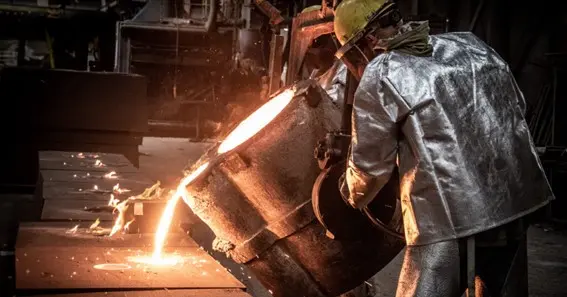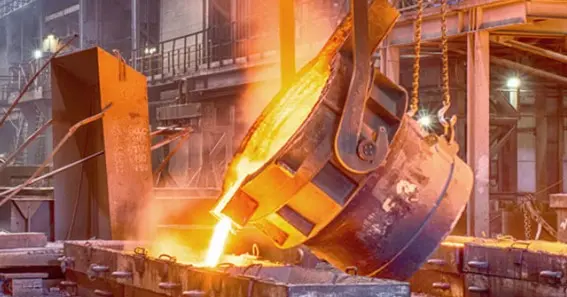What is a foundry? Foundries are crucial to manufacturing and economic progress because they melt and form metals. This inquiry leads us to one of the most important fields that has shaped human history for centuries. The art and science of casting have evolved from ancient times to modern facilities. This article describes what is a foundry, how they work, the types they manufacture, the materials they utilize, their history, and their current role.
What Is A Foundry?
Metals are burnt and molded at foundries using various casting procedures. Raw metal is turned into usable parts and items by a foundry. Melted in a kiln, poured into a mold, and cooled and hardened, this metal can be changed. The final output can be complex machine parts or sturdy buildings.
The procedure begins with selecting raw materials. These are melted at high temperatures. Molten metal is carefully poured into molds to create desired forms. Remove the mold after the metal cools and hardens to reveal a cast metal object ready for finishing and machining. Manufacturing relies on foundries to create aerospace, building, consumer goods, and auto parts. This short briefing should have given you a basic understanding on what is a foundry.
A foundry is an industrial facility where metals are melted and cast into specific shapes, serving as the foundational process for producing metal components used in various manufacturing industries.
Foundation Of Foundries

After what is a foundry, lets discuss a bit on their foundation or history. From the outset, foundries existed. The first foundries were created around 4000 BCE. Copper and bronze were utilized for tools, weapons, and more. Metalworking advanced during the Bronze Age, and foundries were crucial to bronze production. The Iron Age introduced new iron melting and producing methods. Early foundries laid the groundwork for contemporary metallurgy.
The Industrial Revolution transformed casting. The blast furnace made lots of iron and steel, changing manufacturing, construction, and transportation. Foundries generated new ideas, boosting economic and scientific advancement. Today, foundries use advanced technology to swiftly and accurately cast. They continue to innovate and support the industry.
Types Of Foundries
Foundries are categorized by metal and casting method. Sand casting is an ancient and popular metal part-making method. It uses sand models. Investment casting, commonly called lost wax casting, uses ceramic-covered wax models to make molds. Die casting produces exact pieces by pushing molten metal into a mold hole under high pressure. Each casting method has advantages; thus, it can be utilized for different purposes.
Foundry Processes
The foundry process has numerous crucial processes for good casts. Pattern-making begins with a metal, plastic, or wood duplicate of the desired part. The mold for molten metal is constructed using this pattern. The design is placed in a box of sand and tightly packed to produce a mold while sand casting.
Next, melt and pour the material into the mold. A furnace melts metal to the right temperature. Molten metal is then gently poured into the mold until complete. After pouring, the metal cools and hardens. The casting is removed from the body, and any excess material is trimmed off after hardening.
Finish and check the job last. Cleaning removes sand and clay from the casting. Getting the proper size and characteristics may require more than machining, heat treatment, and surface finishing. Next, the casting is inspected for defects and quality. Each casting phase must be done carefully and skillfully to produce high-quality metal pieces.
Materials Used In Foundries

Foundries employ many materials, each chosen for its specific properties and versatility. People employ cast iron and steel because they are robust, durable, and heat-resistant. Many people like cast iron since it’s easy to form and durable. It is ideal for engine blocks, pipes, and heavy machinery parts. Steel is robust and versatile; therefore, it’s utilized in building, automobile parts, and tools.
Foundries commonly use aluminum, copper, and bronze. Lightweight aluminum is ideal for airplanes and cars since it doesn’t rust. Copper and its alloys, including brass and copper, don’t rust and transport electricity well, making them suitable for electrical parts and decorations. Each material has qualities that enable casting, allowing for precise pieces.
Environmental Considerations In Foundry Operations
Now, what is a foundry being clearer for you, lets discuss about their environmental impacts. As business practices change, foundries prioritize sustainability and the environment. Modern foundries promote sustainability and environmental protection in numerous ways. Lowering energy utilization is crucial. Foundries have shifted to energy-efficient burners and processes to save resources and reduce carbon emissions. Foundries recycle scrap metal to reduce waste and remove raw materials.
Foundries must also consider emissions control. High-tech filtration systems and emission control technologies reduce melting and casting pollution. Foundries reuse sand and other mold materials to minimize waste. Foundries use these approaches to reduce their environmental impact and ensure sustainability.
Conclusion
A foundry is a crucial structure where different casting procedures turn raw metals into usable parts. Understanding how complex foundries work, what materials they utilize, and their past and present roles is crucial to understanding many enterprises. Foundries have shaped culture and technology since the beginning. Foundries are vital to many industries, even as they adopt new technologies and greener ways. This article should have provided you with enough knowledge on what is a foundry and its other various details.
FAQ
What Is A Forge Performs?
Foundries melt and cast metals into specified forms in various ways. They make vital parts for numerous companies.
What Do Foundries Use?
Foundries use steel, cast iron, aluminum, copper, and bronze. We choose metals depending on their properties.
How Does Casting Work?
The foundry process includes pattern making, mold preparation, melting and pouring metal, cooling and hardening, finishing, and inspecting to make high-quality castings.
How Do Foundries Help Businesses Today?
Foundries create parts for construction, aircraft, automobiles, and green energy. These pieces advance technology in various ways.
How Do Foundries Handle Ecology?
Modern foundries recycle, limit emissions, and manage waste to support sustainability.
Sources:










